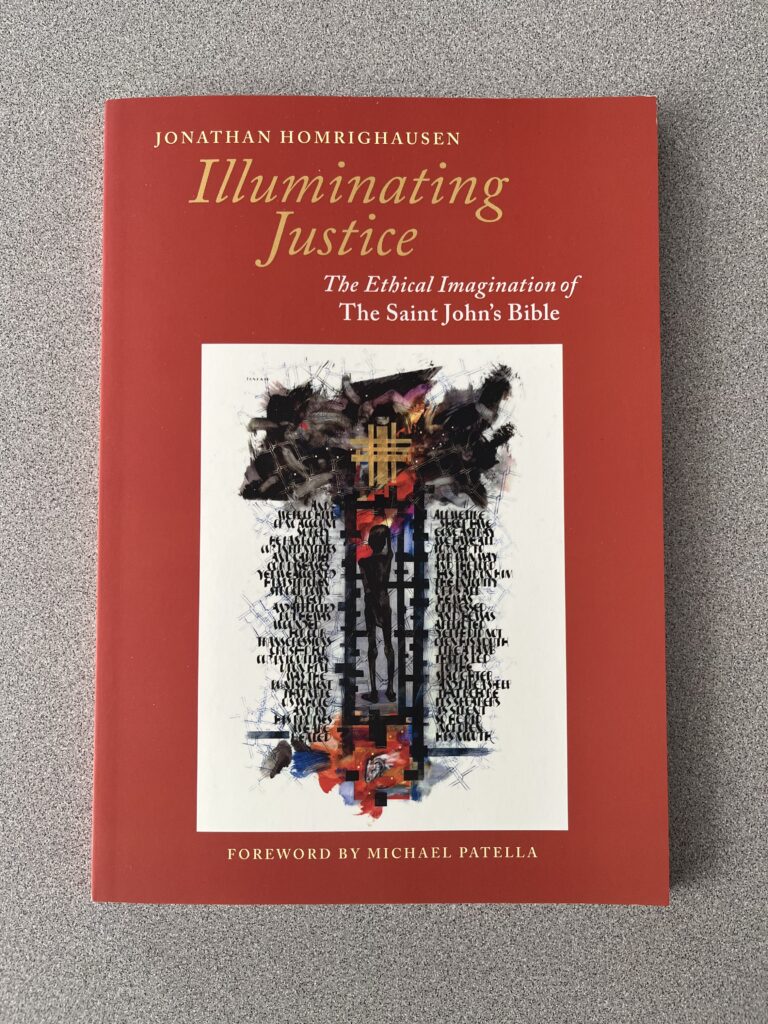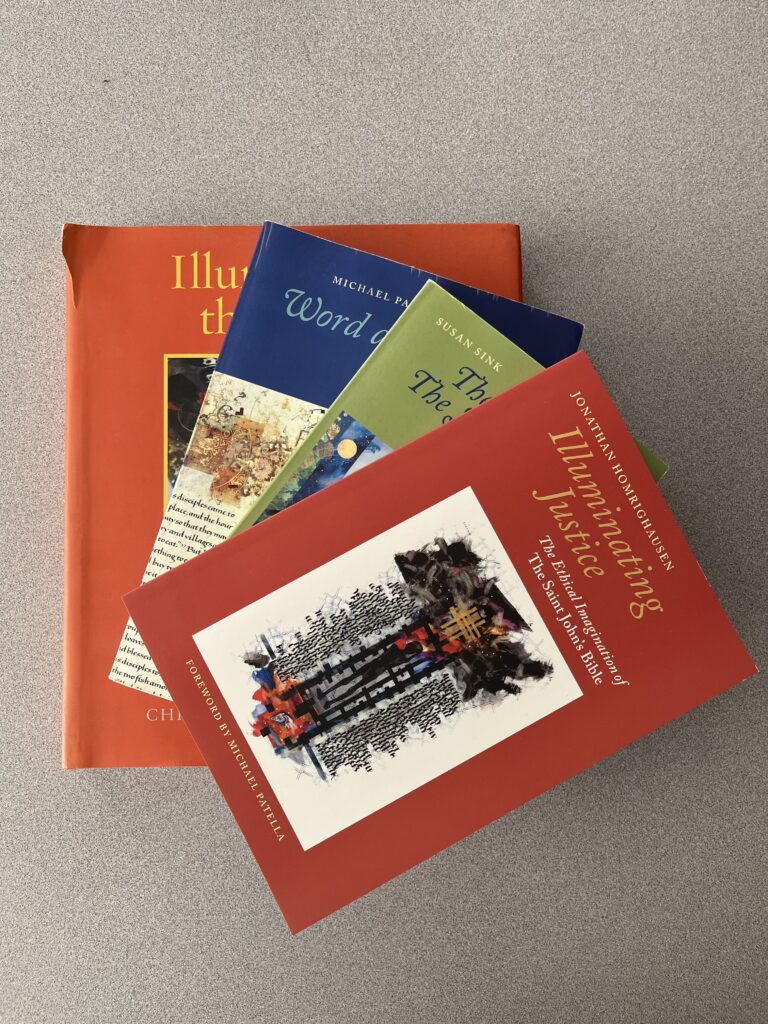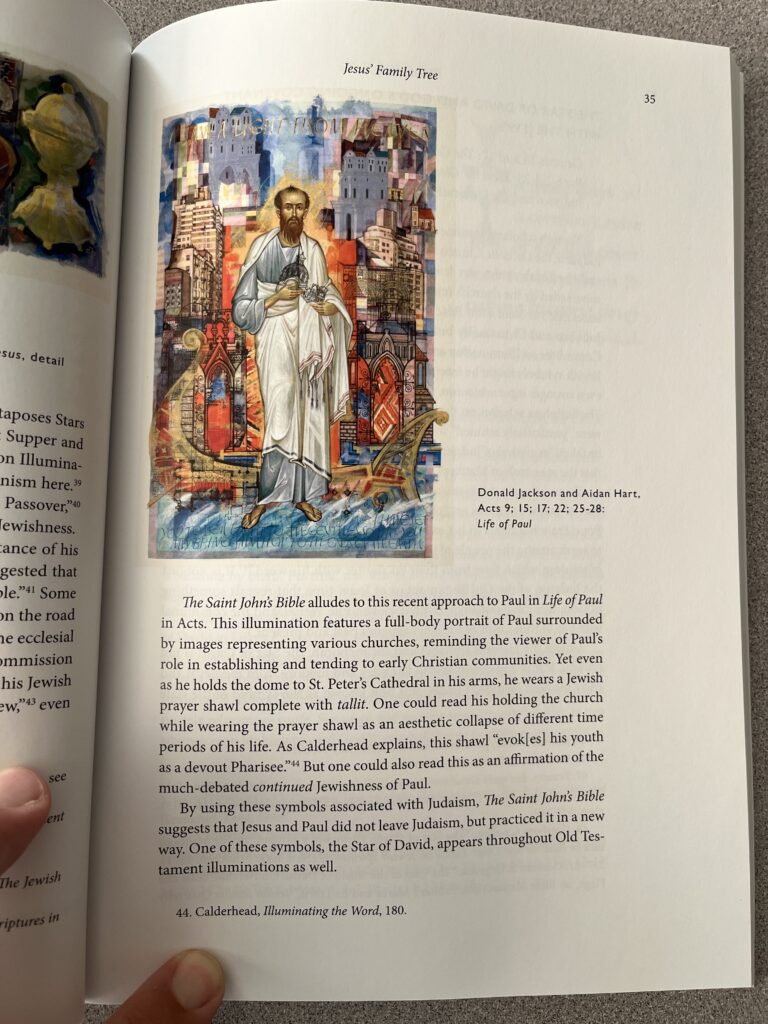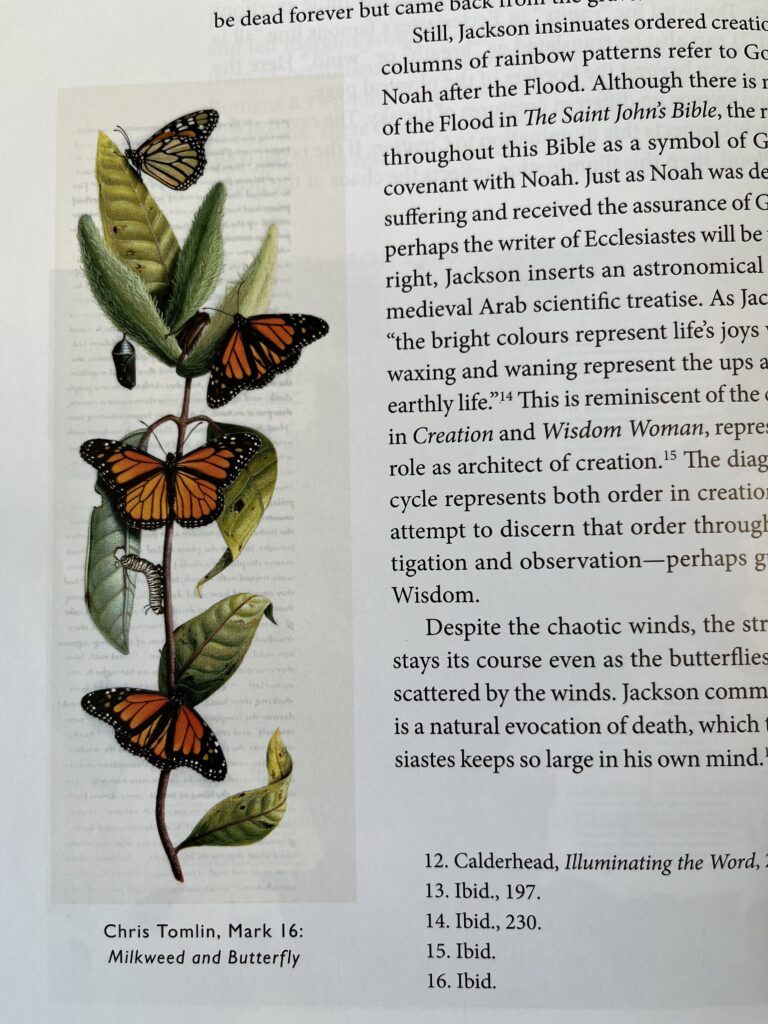Illuminating Justice: The Ethical Imagination of The Saint John’s Bible
By Jonathan Homrighausen
One of the earliest continuing series of posts from my old blog, The Catholic Bibles Blog, concerned The Saint John’s Bible. (See the many posts and interviews here.) Since learning about it in the early 2000’s, it has remained for me a fascination and interest over the years. During that time, I have shared with my high school students a number of prints and videos concerning The Saint John’s Bible, even having one of their Heritage Editions brought to my school for first-hand viewing and a presentation. Begun in 1998 and completed in 2011, “Saint John’s Abbey and University commissioned renowned calligrapher Donald Jackson to produce a hand-written, hand-illuminated Bible.” The SJB remains the first major handwritten and illuminated Catholic Bible since the time of the invention of the printing press. The original is viewable at the Alcuin Library on the campus of St. John’s University.

Since the very beginning of the SJB project, there have been various volumes produced that serve as companions to The Saint John’s Bible. I would certainly highlight the works of Christopher Calderhead, Michael Patella, and Susan Sink as places to begin your deep-dive into The Saint John’s Bible. Over the last half-decade or so, Jonathan Homrighausen has been continuing to delve into the various interpretations of the SJB through two (so far) beautifully crafted volumes. Homrighausen is “a doctoral candidate in Hebrew Bible at Duke University, teaches in Judaic Studies at the College of William & Mary. His research explores the intersection of Hebrew Bible, calligraphic art, and scribal craft.” His most recent work is Planting Letters and Weaving Lines: Calligraphy, The Song of Songs, and The Saint John’s Bible which was published last year. For this review, I decided to look at his first volume from 2018: Illuminating Justice: The Ethical Imagination of The Saint John’s Bible.
To start with, let me say a word about the book itself. Like the other companion volumes mentioned above, Illuminating Justice is printed on a soft glossy paper, which is similar to other titles from Liturgical Press concerning the SJB. Everything that is published with the SJB name on it is made of quality materials and is truly a joy with which to read, study, and pray. This volume is no exception. The print size is eminently readable and the reproduction of the various SJB illuminations are crisp and perfectly placed in the text. While not the same as seeing the original or the Heritage Editions of the SJB in person, they provide the necessary facsimile to compliment Homrighauen’s insights. At the end of the text, a robust bibliography and two indexes provide the reader with more avenues for exploration if their interest is piqued.

The opening chapter provides the launching point for the reader. Homrighausen emphasizes the intertextuality of the SJB by showing how the artists, led by Donald Jackson, and the Committee on Illumination and Text (CIT), which provided the theological vision for the work, came together to ensure that there would be themes and motifs that ran through the entire work. In this more canonical approach, sometimes these connections were intentional, while at other times the Spirit was the driving force (7). While never denying the many fruits of historical criticism, the SJB was created to show the interrelatedness between the 73 books of the Catholic Bible (NRSVCE). Referring to Fr. Michael Patella’s work Word and Image, Homrighausen points that “The Saint John’s Bible creates intertextuality through the use of repeated iconography. The intertextuality of The Saint John’s Bible came from both the Committee on the Illumination and Text’s creative free associations and Donald Jackson’s and the other artists’ lexicon of visual leitmotifs that appear throughout the text (6).” Spanning from both ancient and medieval iconography to modern symbolism and imagery, the SJB provides a place of encounter from which to address various issues related to ethics and justice.
While not an exhaustive study of all the ethical or justice-related issues found in The Saint John’s Bible, Homrighausen focuses on three main areas: 1) Peace between Jews and Christians; 2) Women and Wisdom Women; 3) Caring for Creation. All of these sections are brought together by the biblical image of a tree. Beginning with the beautiful Genealogy of Jesus (Matthew’s Family Tree) and concluding with the Vision of the New Jerusalem from Revelation (both rendered by Donald Jackson), Homrighausen shows how the various illuminations and imagery address these three areas of justice that are found in the biblical text.
While there are dozens of fascinating connections and themes that Homrighausen makes, one stood out to me. The first was to see the SJB as a book that is meant to bring healing between the Jewish people and the Catholic Church. No need here to go into the issues and events that have caused both distrust and pain between the two communities, but the SJB is intentional in showing both the Jewish roots of Jesus, as well as other key figures of the New Testament, including St. Paul. The Genealogy of Jesus piece done by Donald Jackson is in the form of a menorah and includes the relatives of Jesus written in the Hebrew language. DNA strands are found between the arms of the menorah that “point to the significance of heredity in passing on Jewish identity (19).” (Interesting is the absence of a DNA strand next to St. Joseph.) In addition, there are Stars of David subtly placed in various pieces throughout the New Testament, most notably the Baptism of Jesus and the Eucharist. The Life of Paul portrait (completed by Donald Jackson and Aidan Hart) emphasizes the role of Paul in establishing so many early Christian communities, “yet even as he holds the dome to St. Peter’s Cathedral in his arms, he wears a Jewish prayer shawl complete with tallit…one could also read this as an affirmation of the much-debated continued Jewishness of Paul (35).” The SJB sees the way forward in Jewish-Catholic relations as one of dialogue and mutual understanding. Perhaps The Saint John’s Bible can provide a small place where that conversation can begin.

Overall, there is a lot to discover in Homrighausen’s treatment of the theme of ethics and justice in the Saint John’s Bible. It really does just scratch the surface. If you are at all interested in The Saint John’s Bible, modern iconography, and/or the social justice teachings of the Catholic Church, this is a lovely volume to own and utilize. Personally, it was wonderful to be able to reexamine the many illuminations of the SJB in a new way. On a personal note, I loved reading the discussion about the use of butterflies in the SJB, as I am now working on building up a small butterfly garden in my home. Around ten years ago, when I first encountered the Milkweed and Butterfly image created by Chris Tomlin for Mark 16, I really had no first hand experience of milkweed or all that goes with cultivating a butterfly garden. Having now been intentional in creating this space in my backyard, I appreciate Homrighausen connecting that image with the disorder to order theme found in his section on the environment and creation (84). While my garden may have the look of disorder right now, there is indeed a designer (perhaps not intelligent!) who is behind it all.
I want to thank Liturgical Press for providing me a review copy in exchange for an honest review.

Has it always been impossible to see if text in a blog post is a link? “See the many posts and interviews here” looks like all plain text, unless I hover the mouse over the link.
One of these days, I hope to get my hands on that 7-volume hardcover set of the Saint John’s Bible.
Just found this while looking for reviews of my new book. Thank you for taking the time to read my first one! What an honor!
Everyone ok out there? Hasn’t been any updates in two months. Praying for everyone
Yep! Thanks for thinking of me. I recently took a new job that has been absorbing a lot of my time. I’m gradually working on a new post that should be finished in a day or two. I hope your summer is going well.
Marc